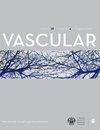Anatomical variations of origin of the internal carotid artery: Report of two cases and systematic review of the literature
IF 1
4区 医学
Q4 PERIPHERAL VASCULAR DISEASE
引用次数: 0
Abstract
BackgroundAnatomical variations of origin of the internal carotid artery (ICA) are very uncommon and may pose a diagnostic and therapeutic challenge.ObjectiveWe report a case of direct origin of the right ICA from the innominate artery (aplasia of common carotid artery) and a case of duplication of right ICA in healthy patients who performed duplex ultrasound (DUS) for primary cardiovascular prevention screening.MethodsIn both cases, the ultrasound scan was performed both in a transverse plane and on the longitudinal axis, and in one of the two cases, a computed tomography angiography was performed to confirm the diagnosis. A review of the current literature about anatomical variations of origin of carotid arteries was also performed.ResultsThe most frequent congenital anomaly is represented by the aplasia of the CCA, followed by the agenesis and by the duplication of the ICA. In most cases, the anomaly is discovered occasionally and symptoms are aspecific. Diagnosis is usually confirmed through a multimodality imaging approach, including DUS of extracranial carotid arteries, magnetic resonance imaging (MRI), and computed tomographic angiography. In most cases, treatment was conservative, with pharmacological therapy aimed at the symptoms.ConclusionThe recognition of such variations is mandatory, particularly when the patient needs a surgical treatment that may involve the vessel with the anatomical variations.颈内动脉起源的解剖变异:两例病例报告和文献系统回顾
背景颈内动脉(ICA)起源的解剖变异非常罕见,可能会给诊断和治疗带来挑战。目的我们报告了一例右侧ICA直接起源于髂内动脉(颈总动脉增生)的病例和一例右侧ICA重复的病例,这两例病例均为健康患者,他们在进行心血管初级预防筛查时接受了双工超声(DUS)检查。方法在这两个病例中,超声扫描均在横向平面和纵向轴上进行,其中一个病例还进行了计算机断层扫描血管造影以确诊。结果最常见的先天性畸形是 CCA 增生,其次是缺失和 ICA 重复。在大多数病例中,畸形是偶尔发现的,症状也不明显。诊断通常需要通过多模态成像方法来确认,包括颅外颈动脉的 DUS、磁共振成像(MRI)和计算机断层扫描血管造影。在大多数病例中,治疗都是保守的,针对症状进行药物治疗。
本文章由计算机程序翻译,如有差异,请以英文原文为准。
求助全文
约1分钟内获得全文
求助全文
来源期刊

Vascular
医学-外周血管病
CiteScore
2.30
自引率
9.10%
发文量
196
审稿时长
6-12 weeks
期刊介绍:
Vascular provides readers with new and unusual up-to-date articles and case reports focusing on vascular and endovascular topics. It is a highly international forum for the discussion and debate of all aspects of this distinct surgical specialty. It also features opinion pieces, literature reviews and controversial issues presented from various points of view.
 求助内容:
求助内容: 应助结果提醒方式:
应助结果提醒方式:


